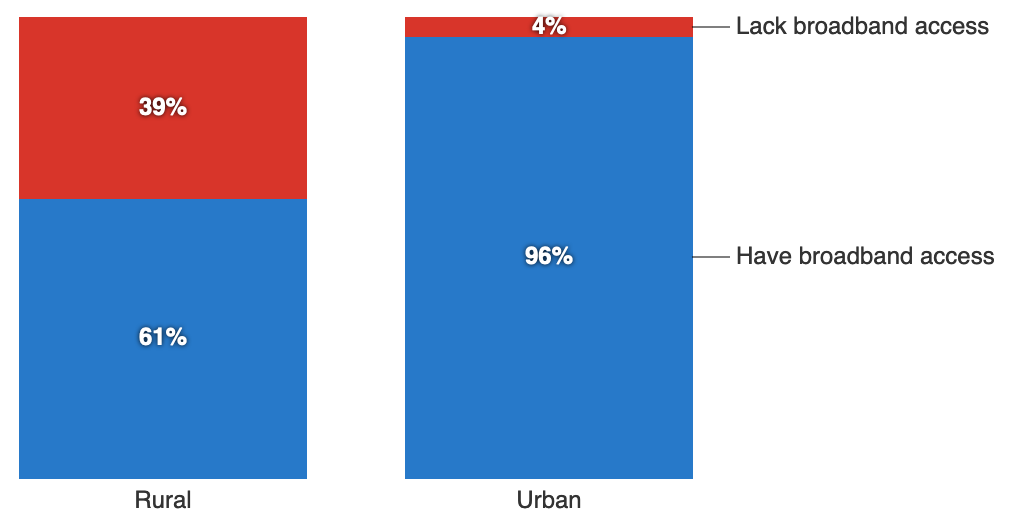Key Points
- Ensure farmers have the Right to Repair their own equipment
- Protect farmers from predatory patent lawsuits from seed corporations
- Reform federal subsidies to go to small and mid sized farms instead of disproportionately going to the largest producers
- Current food system accounts for 25% of greenhouse gas emissions- help farms of all sizes transition to sustainable agricultural practices
- Enforce and reform the Clean Air and Water Acts for large factory farms to ensure proper oversight of pollution
- Ensure high-speed broadband internet access
- Stop consolidating rural schools and start building rural schools that can access and utilize distance learning opportunities
- Incentivize cooperative business models and utilities- food co-ops, credit unions, and farm co-ops
- Invest in public transportation to better connect residents and provide access to jobs, schools, medical facilities, shopping, recreation, and more
Right to Repair
Shouldn't farmers be able to repair the equipment that they own? YES! There is no situation, to me, where it makes sense to restrict anyone's right to repair something that they own. Not only should we all have the freedom to our own equipment and vehicles, but local repair shops should have all of the necessary information to properly and efficiently make repairs. Many farms are in remote locations and do not have the luxury to wait for new parts from dealers, which could lead to missing crop target pricing and losing valuable revenue.
This does not mean I support the right to modify manufacturer's software to fit your needs. There needs to be a happy medium where equipment owners are able to physically repair their machines without software restricting. It is wrong that only manufacturers or authorized service providers have the power to unlock software blocks. Let people repair their machines and stop software from restrictive practices.
Read more here:
- NPR - DIY Tractor Repair Runs Afoul Of Copyright Law
- Bold Nebraska - Support Fair Repair in Nebraska
- Repair.org
Agriculture
Below is a list of needed legislation proposals to aid and improve agriculture.
- Strengthen oversight of foreign ownership of farmland
- Reform federal subsidies to go to small and mid sized farms instead of disproportionately going to the largest producers
- Provide relief to help prevent independent family farm bankruptcies
- Strengthen organic standards so mega-farms cannot undermine rules to cut out small producers
- Provide grants and debt relief to farms to support their transition to sustainable farming practices to fight climate change
Clean Air and Water Acts
We need a Clean Water Act for the 21st century, the original act was passed in 1972 and most recently amended in 1987. The Clean Water Act provides basic structure for regulating discharges of pollutants into the waters of this nation. There are many omissions that do not account for legacy pollution and emerging problems that were not addressed in the original bill or from growing issues from climate change.
To bring this bill up to date we need to do the following:
- Improve investments in water infrastructure to ensure aging systems do not fail like we are seeing most famously in Flint, Michigan
- Ensuring water stays in rivers and streams to support their biological functioning
- Including more green infrastructure initiatives
- Removing the term "navigable waters" to make it clear that the law covers all types of waterways- tributaries, wetlands, headwaters, etc.
- Address climate change so we are prepared for more severe storms
The Clean Air Act was first passed in 1963 to control air pollution on a national level. The most recent amendment was in 1990 to address acid rain, ozone depletion, and increased enforcement authority. Like the Clean Water Act, we need to make amendments to ensure we are protecting the environment from today's emerging issues. We need to strengthen the standards across the board and aggressively enforce against companies that do not adhere to the new policies.
High-speed Internet Access
Access to internet is a necessity in today's society, we need to ensure this right to everyone. In areas where there is only one or two providers to choose from we need to ensure greater competition in the market so we are not paying higher in prices for lower quality in service. The FCC (Federal Communications Commission) has a current standard for adequate speeds to be 25mbps download speed and 3mbps upload speed. However, these speeds are not readily available in rural areas (seen below).
So how do we achieve access for all? A fixed wireless solution is what I will propose to ensure all households, regardless of how remote they are, are provided access to high-speed internet. Through the FCC, we must continue to expand the grant and loan programs to increase investment in internet infrastructure in rural areas. If you are interested in the specifics of how a fixed wireless solution works, you can read more here.
Internet should be classified as a public utility at the federal level, akin to water and gas.
Rural Schools
Education in general needs to be addressed in a big way, but also specific issues only related to rural schools needs attention as well. Rural schools face many of the same issues as urban schools, but also have trouble recruiting and retaining teachers. At the same time, rural schools also hold unique strengths and opportunities. They have strong community support, including opportunities for students to connect directly with future employers.
We need to ensure rural schools have fair chances to receive and compete for federal education funds. Providing wraparound services to students in need who may be dealing with one or many nonacademic issues. Incentivize rural schools to lead the way in virtual online learning to prevent school closings and consolidations. These proposals are by no means exhaustive, but a targeted start to put a strong focus on rural students to allow them to succeed. Enacting these plans, in addition to aiding agriculture and fighting climate change, will boost rural communities for years to come.
Public Transportation
There is a need for public transportation to connect rural communities with urban areas. America’s rural population is declining, but ridership has increased from 2007 to 2015. This comes out to an 8.6 percent increase in per-capita rural ridership over the past 8 years, and a 7.8 percent increase in total rural ridership. Compared to urban public transit, ridership increased by 2.3 percent in the same time period. Public transit can help promote active lifestyles in rural communities struggling with health problems such as obesity, and can link people with necessary healthcare services. Rural public transportation can be an important force in supporting local economies by connecting residents with local businesses and job opportunities. Rural public transit spending per capita is lower than in urban areas, increasing federal investments will be a big win for everyone.
You can read more about wide ranging public transportation proposals on the Other Priorities page.

